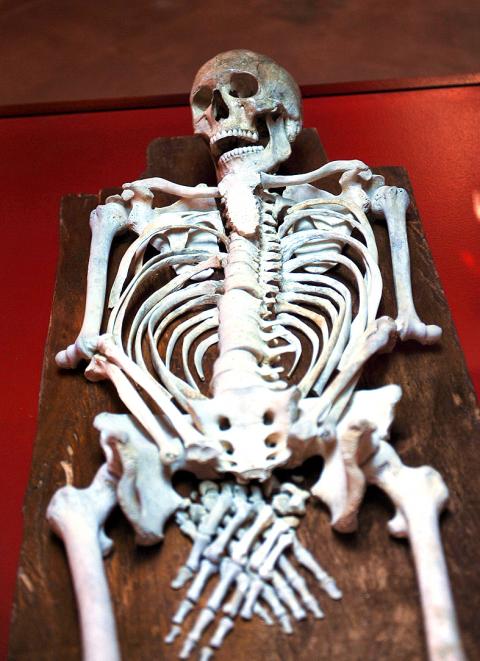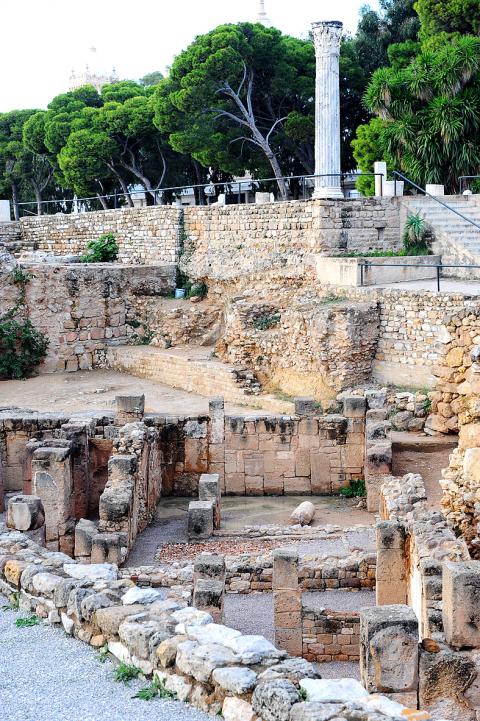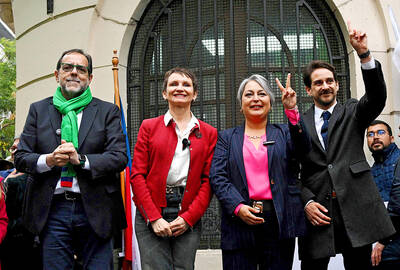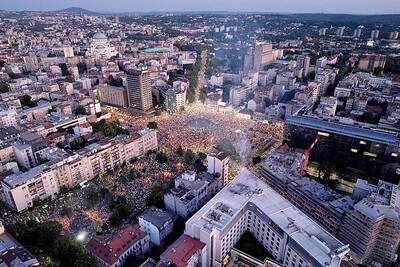Clad in a white linen tunic, sandals in the ancient Carthaginian style and a pendant and beads like those found with his remains, 2,500-year-old “Ariche,” also known as the Byrsa Boy, has virtually come back to life on the sacred hill of Byrsa where he was born.
The outcome of scientific cooperation between France and Tunisia, the young man has been remodeled and returned to his native soil in historical Carthage, a city state that lasted from 814BC to 146BC. He will be given a place of honor in the museum of modern-day Carthage, north of Tunis.
“The distance that separates the centuries has been erased, the bones are given flesh and the eyes light up anew in a young man who lived right here six centuries before our own era,” French ambassador Pierre Menat said at the opening of the exhibition last week.

Photo: AFP
The modern history of the youth of Byrsa began in 1994 with the fortuitous discovery of a sepulchre on the southern flank of the hill, which is one of the most famous sites of ancient Carthage. A joint Franco-Tunisian team moved in to excavate.
“Gone too soon, taken prematurely from life and the love of those close to him ... He was doubtless of noble birth and his body was buried in this generous African soil,” said Leila Sebai, president of the International Council of Museums and commissioner of the exhibition.
An anthropological study of the skeleton showed that the man died between the age of 19 and 24, had a pretty robust physique and was 1.7m tall, according to a description by Jean Paul Morel, director of the French archeological team at Carthage Byrsa.

Photo: AFP
The man from Byrsa has been rebaptized Ariche — meaning “desired man” — at the initiative of Tunisian Culture Minister Abderraouf Basti, who inaugurated the exhibition.
Ariche has regained an almost living human appearance very close in physiognomy to a Carthaginian of the 6th century BC after a dermoplastic reconstruction undertaken in Paris by Elisabeth Daynes, a sculptor specializing in hyper-realistic reconstructions.
“He comes back to us thanks to scientific rigor, notably that of paleo-anthropology and forensic medicine, but also the magic of art, that of Elisabeth Daynes, who knows how to bring many faces back from the distant past,” Sebai said.

Photo: AFP
Dermoplastic reconstruction is based on a scientific technique that enables experts to restore the features of an individual with 95 percent accuracy, though some -aspects, such as the color of the eyes and hair remain partially subjective, she added.
“We can clearly see that this exceptional witness to Carthage in the Punic era is a Mediterranean man, he has all the characteristics,” said Sihem Roudesli, a paleo-anthropologist at the Tunisian National Heritage Institute.
“I hope that like his contemporaries, legendary sailors and bringers of civilization, this young man can travel across the seas to bear witness on other continents to the greatness of Carthage,” Menat said.
Repatriated on Sept. 24, Ariche will be on show at Byrsa until the end of March when he will travel to Lebanon, the land of the Phoenicians who founded Carthage, for an exhibition at the American University of Beirut.

Two former Chilean ministers are among four candidates competing this weekend for the presidential nomination of the left ahead of November elections dominated by rising levels of violent crime. More than 15 million voters are eligible to choose today between former minister of labor Jeannette Jara, former minister of the interior Carolina Toha and two members of parliament, Gonzalo Winter and Jaime Mulet, to represent the left against a resurgent right. The primary is open to members of the parties within Chilean President Gabriel Boric’s ruling left-wing coalition and other voters who are not affiliated with specific parties. A recent poll by the

TENSIONS HIGH: For more than half a year, students have organized protests around the country, while the Serbian presaident said they are part of a foreign plot About 140,000 protesters rallied in Belgrade, the largest turnout over the past few months, as student-led demonstrations mount pressure on the populist government to call early elections. The rally was one of the largest in more than half a year student-led actions, which began in November last year after the roof of a train station collapsed in the northern city of Novi Sad, killing 16 people — a tragedy widely blamed on entrenched corruption. On Saturday, a sea of protesters filled Belgrade’s largest square and poured into several surrounding streets. The independent protest monitor Archive of Public Gatherings estimated the

Irish-language rap group Kneecap on Saturday gave an impassioned performance for tens of thousands of fans at the Glastonbury Festival despite criticism by British politicians and a terror charge for one of the trio. Liam Og O hAnnaidh, who performs under the stage name Mo Chara, has been charged under the UK’s Terrorism Act with supporting a proscribed organization for allegedly waving a Hezbollah flag at a concert in London in November last year. The rapper, who was charged under the anglicized version of his name, Liam O’Hanna, is on unconditional bail before a further court hearing in August. “Glastonbury,

FLYBY: The object, appears to be traveling more than 60 kilometers per second, meaning it is not bound by the sun’s orbit, astronomers studying 3I/Atlas said Astronomers on Wednesday confirmed the discovery of an interstellar object racing through the solar system — only the third-ever spotted, although scientists suspect many more might slip past unnoticed. The visitor from the stars, designated 3I/Atlas, is likely the largest yet detected, and has been classified as a comet, or cosmic snowball. “It looks kind of fuzzy,” said Peter Veres, an astronomer with the International Astronomical Union’s Minor Planet Center, which was responsible for the official confirmation. “It seems that there is some gas around it, and I think one or two telescopes reported a very short tail.” Originally known as A11pl3Z before